Coping with Climate Change:China’s Efforts and Their Sociological Significance
Hong Dayong
There is no doubt that global climate change is one of the important problems of the world. Every negotiation on global cooperation to combat climate change has attracted world-wide attention. People feel greatly inspired at every bit of progress made in these negotiations and frustrated by their failures. With the distinct changes in the global political climate, the execution of the newly-concludedParis Agreementhas aroused even more concerns about climate change. Revolving around the efforts made by the Chinese government in coping with climate change and the primary challenges facing it, this paper delves into the sociological significance of practices to combat climate change in a bid to encourage sociology and other social sciences to engage in more substantial research on how to cope with climate change.
1. Unbalanced awareness about climate change
In scientific communities, many people consider climate change to be the biggest environmental risk facing human society since the industrial revolution. The risk is embodied by the constant rise of greenhouse gases in the atmosphere (Figure 1), the root of which remains deeply entrenched in modern society. Therefore, coping with climate change entails positive efforts to reform modern society. As this basic consensus among scientific communities has been increasingly received by leaders of countries all over the world many countries are endeavoring to advance global governance on climate change.In 1992, the Intergovernmental Negotiating Committee completed theUnited Nations Framework Convention on Climate Change(UNFCCC), marking a landmark leap forward. On November 4, 2016,The Paris Agreementwhich was the product of difficult negotiations between countries finally came into force. At present, this agreement has been officially approved by 74 countries whose greenhouse gas emissions account for 58.82%. This agreement has set the stage for globally concerted efforts in climate change after 2020, making itself another landmark in global governance on climate change.
However, in scientific communities, there is an imbalance in discussion on climate change between natural science and social science. Sociology has had very limited participation in discussions on climate change. For example, in the prestigious China Academic Journals Full-text Database (CNKI, http://acad.cnki.net/), when the key words “climate change”are checked, there are 11,626 pieces of literature (as of November 8, 2016). However, if the natural science journals are excluded, there are only 1,844. Literature on climate change in journals for the humanities and social sciences only account for 15.9%. Among them, only a very small number of articles on climate change are written by sociologists. When the“climate change” is checked among the 2,889 pieces of literature published in China’s most excellent sociological professional journalSociological Studies,there is only one article (Zhang, 2011). Chinese socialists have paid little attention to why climate change happens, what impact it exerts and how to cope with it from the sociological perspective. Most people seem to take it for granted that climate change is the concern of natural scientists.
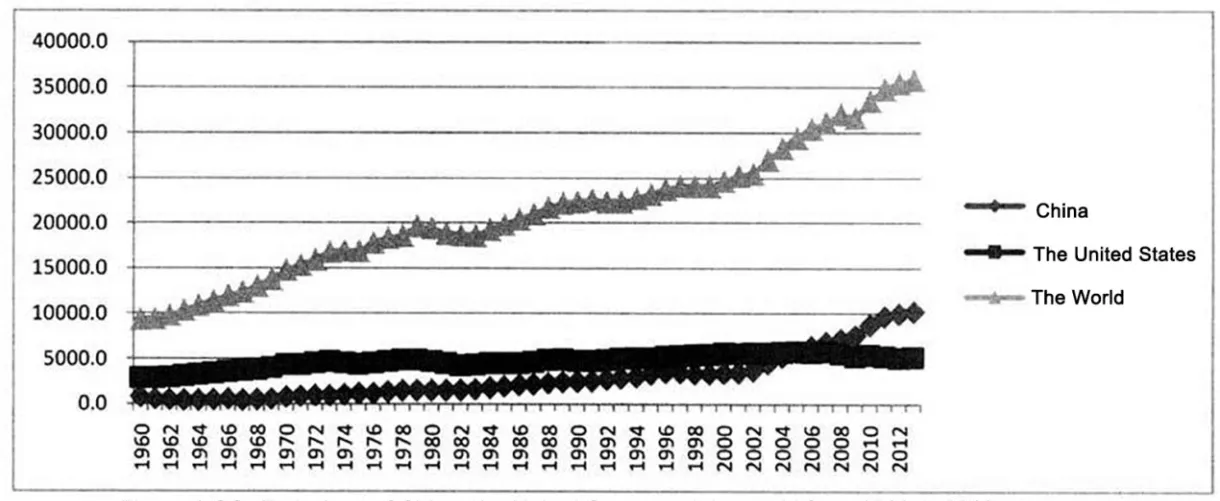
Figure 1 CO2 Emissions of China, the United States and the world from 1960 to 2013(Unit: million ton)Data Source: World Bank Statistical Yearbook. Retrieved from http://data. worldbank. org/indicator/EN. ATM. CO2E. KT
As for the public, if you interview a person at random and ask them whether they are aware of climate change, as often as not, they have heard of it, but do not know it well, or can only talk with you about “weather change”. According to the data from the 2010 Chinese General Social Survey (CGSS) by Renmin University, only 5.7% of interviewees regard“climate change” as China’s severest environmental issue (see Figure 1). A recent study shows, about 63% of interviewees have heard of “global climate change”, while 23.6% of interviewees have “never heard of it” and 13.4% of interviewees have “no knowledge of it at all”. Scholars (Huang, Ren& He,2016) in their analysis point out that, Chinese citizens are “superficially and somewhat inaccurately” aware of global climate change.
In fact, like many other countries, Chinese citizens are nagged by multiple problems arising from social transformations, not only environmental woes. For example, according to data from 2010 Chinese General Social Survey, among a dozen social agendas such as medical care, education,crime, environment, immigrants, economy, terrorism and poverty, interviewees ranked their concerns as follows; medical care (30.7%), education (23.5%),poverty (16.3%), economy (15.0%), crime (6.1%) and environment (5.5%). This is the case in developed countries as well, environmental problems do not rank highest in the view of their citizens either.①According to the International Social Survey Programme in 2010 (ISSP2010), citizens from high-income countries think the most important issues are the economy (29.7%), medical care (23.9%), education (15.4%), etc. The environment ranks sixth (6.6%).If taking the environmental agenda into consideration alone, Chinese interviewees pay more attention to air pollution (34.7%), water pollution (20.0%), garbage pollution (17.7%) and other problems that have a close relationship with their daily lives, and climate change is ranked at the bottom. Compared with developed countries, China shows an appreciable difference in the rankings (see table 1②Based on relevant classification of all countries’ income levels as per GNI Per Capita by the World Bank in 2010, we classify 30 countries included in ISSP2010 Data into two categories, middle-income countries and high-income countries. The former contains 10 countries while the latter contains the remaining 20 countries. For more direct comparison, we list China as a separate category.).
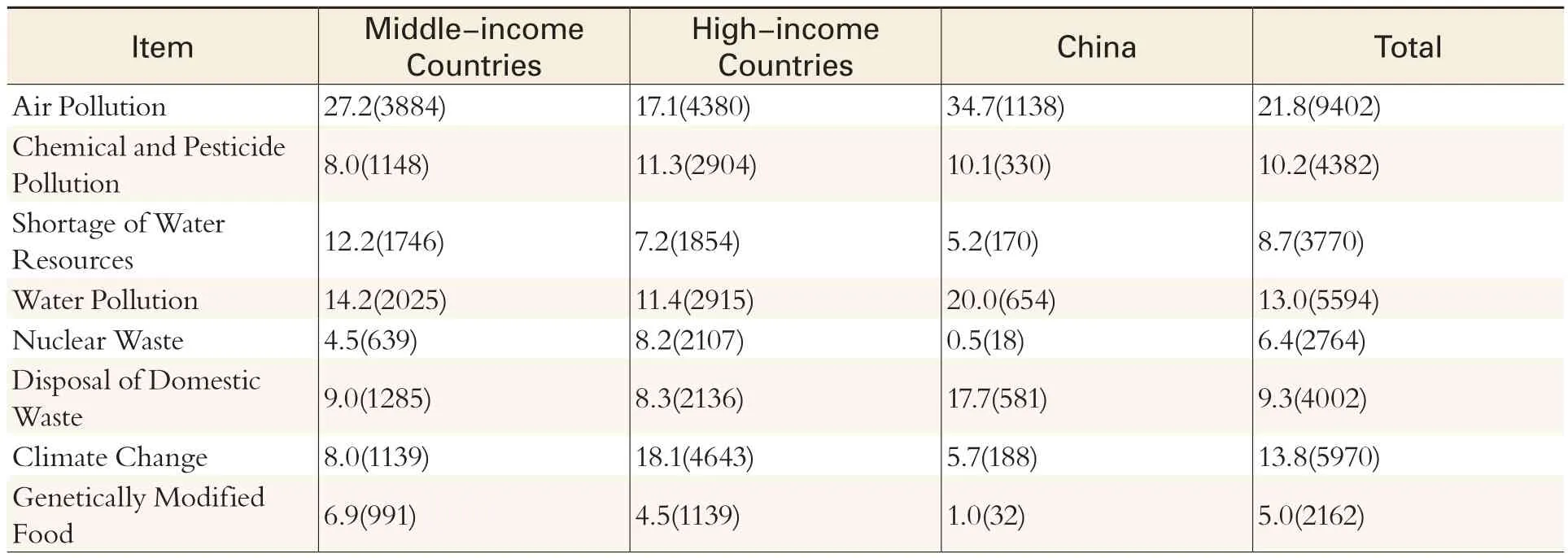
Table 1 The Currently Most Pressing Environment Issues of the Country (Percentage + Number of Samples)

Note: The total number of samples should be 45,564 and those unselected is regarded as missing data.Data Source: 2010 International Social Survey Programme (1SSP2010); 2010 Chinese General Social Survey (CGSS2010)
2. China’s efforts in coping with climate change
Although there is an imbalance of research and awareness about climate change, the Chinese government has acknowledged the severity of global climate change and taken positive, diverse countermeasures to cope with it. China has not only approved a series of important documents on climate change such as theUNFCCC,Kyoto Protocoland theParis Agreement, but also put into practice a variety of results-oriented initiatives to mitigate and adapt to climate change. Since the United Nations Conference on Environment and Development in 1992, the Chinese government has taken the lead in enacting the China Agenda for the21st Centurythe White Paper of China on Population, Environment and Development in the 21st Centuryand establishing the National Climate Change Coordination Committee consisting of governmental departments,and has done a great deal in research, formulation and coordination of polices relating to climate change. Since 2001, the National Climate Change Coordination Committee has initiated the compiling of thePeople’s Republic of China Initial National Communication on Climate Changeand submitted the report to the Tenth Meeting of the Conference of the Parties to theUnited Nations Framework Convention on Climate Changeat the end of 2004.In 2007, China established the “National Leading Group to Address Climate Change and Energy Conservation & Pollutant Discharge Reduction”,and formulated and releasedChina’s National Climate Change Program. Since 2008, the Chinese government has released a series of national reports ofChina’s Policies and Actions for Addressing Climate Changeand announced the progress made by China in coping with climate change at home and abroad.
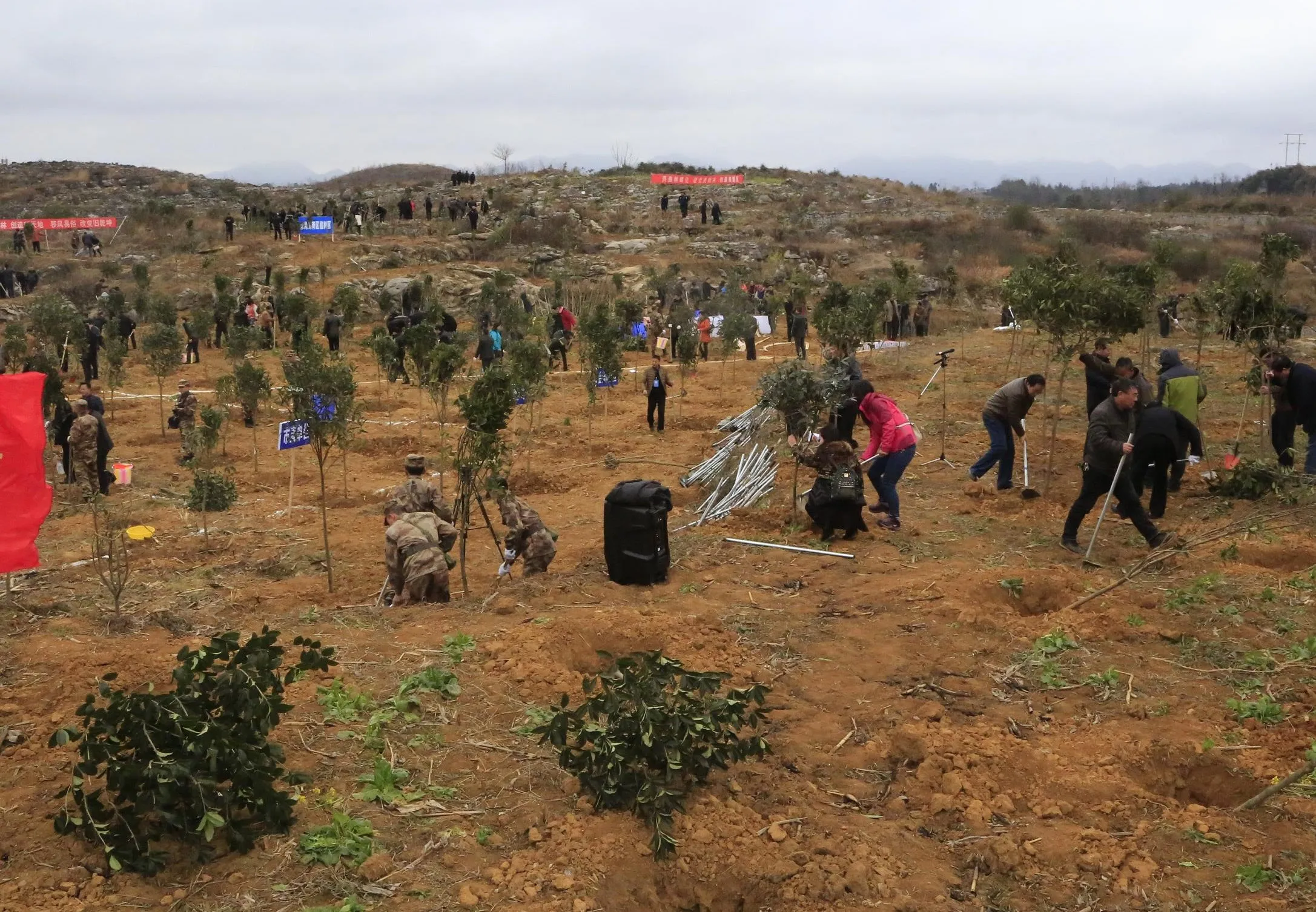
reforestation movement
In China, the National Congress of the CPC has exerted a great impact on China’s domestic governance and foreign affairs. In 2007, the 17th National Congress of the CPC included climate change in their agenda for the first time and pledged to “strengthen the capacity building on combating climate change and make new contributions to protecting global climate”. In 2012, the 18th National Congress of the CPC vowed to “stick to the principle of common but differentiated responsibilities, equity and respective capabilities and join hands with the international society in positively coping with global climate change” and threw light on China’s fundamental road in coping with climate change.In addition, it needs to be emphasized that these practices have awakened the Chinese government to the fact that environmental protection and combating climate change should be combined with advancing more efficient development and across-the-board social reform. In 2003, China put forward the Scientific Outlook on Development.In 2007, the report of the 17th National Congress of the CPC proposed to build an “ecological civilization”. The concept promotes forming an energy-saving, resource-efficient and environmentfriendly structure of industries, pattern of growth and mode of consumption. In 2012, the report of the 18th National Congress of the CPC put forth giving high priority to building an ecological civilization and incorporating into it all aspects and processes of advancing economic, political,cultural, and social progress, working hard to build a beautiful country, achieve lasting and sustainable development, and contributing China’s share to global ecological security. Since the Third Plenary Session of the 18th CPC Central Committee, the building of China’s ecological civilization system has shifted into higher gear and a systematic, sound ecological civilization system is taking shape. Since 2015, China has, in quick succession, introduced a series of important policies including the “harshestever” revisedEnvironmental Protection Law of the People’s Republic of China and the Master Plan on Ecological Civilization Structural Reform. At the end of 2015, the Fifth Plenary Session of the 18th CPC Central Committee was held and put forward five guiding conceptions to steer future development in China with the emphasis on “green development”.The “green development” conception adheres to the basic state policy of saving resources and protecting the environment, follows a developmental path characterized by higher productivity, general affluence and a sound ecosystem, accelerates the building of a resource-conserving and environmentally friendly society, and realizes the importance of harmony between human beings and nature.
As a response to the CPC guiding principles, the national Five-Year Plan has played a direct role in advancing green development and fighting climate change. Since the 11th Five-Year Plan(2005–2010)listed energy consumption of per unit of GDP,total discharge of major pollutants, forest coverage and other environmental indicators as obligatory targets,①Obligatory targets refer to the targets that further define and enhance governments’ responsibilities based on anticipated targets. They are requirements the Central Government puts forward for the work of its relevant departments and local governments in public service and public interest-related sectors. The governments should reasonably allocate public resources and effectively exercise administrative power to ensure the realization of these targets.these indicators saw expansion in extent,enrichment in contents and increasing measurability in requirements in the following 12th Five-Year Plan(2010–2015) and in the 13th Five-Year Plan(2015–2020). Among the twenty-five main indicators stipulated in the 13th Five-Year Plan, there were ten resource and environmental indicators, and all of them were obligatory. In comparison with those of 2015, energy consumption of per unit of GDP reduced by 15%, the non-fossil energy rose by 3% of primary energy consumption and the carbon dioxide emissions per unit of GDP fell by 18%. In addition,this plan established a special chapter for “positively coping with global climate change”. According to real statistical data, China’s efforts in climate change have borne fruit in some respects. For example,since 2008, the growth rate of China’s GDP has notably outpaced that of total energy consumption.Since launching the Reform and Opening-up, China has seen a constant drop in energy consumption per RMB 10,000 of GDP. And by 2014, it had fallen to 0.7 standard coal per RMB 10,000 of GDP (See Figure 2). During the implementation period of the 12th Five-Year Plan, carbon intensity went down by 20%,which exceeded the target of 17% set by the 12th Five-Year Plan.②The State Council Information Office briefed the 2016 annual report China’s Policies and Actions for Addressing Climate Change. Retrieved from: http://www.gov.cn/xinwen/2016-11/01/content_5127079.htm
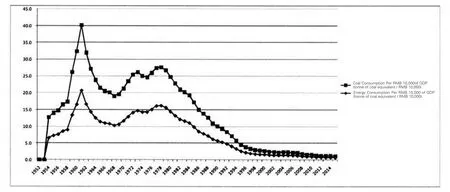
Figure 2 China's Energy Consumption Per RMB 10000 of GDP and Coal Consumption Per RMB 10000 of GDP from 1952 to 2014Data Source: Official Wabsite of National Bureau of Statistics of China. Retrieved from http://www.stats.gov.cn/ztjc/ztsj/201502/P020150212308266514561.pdf
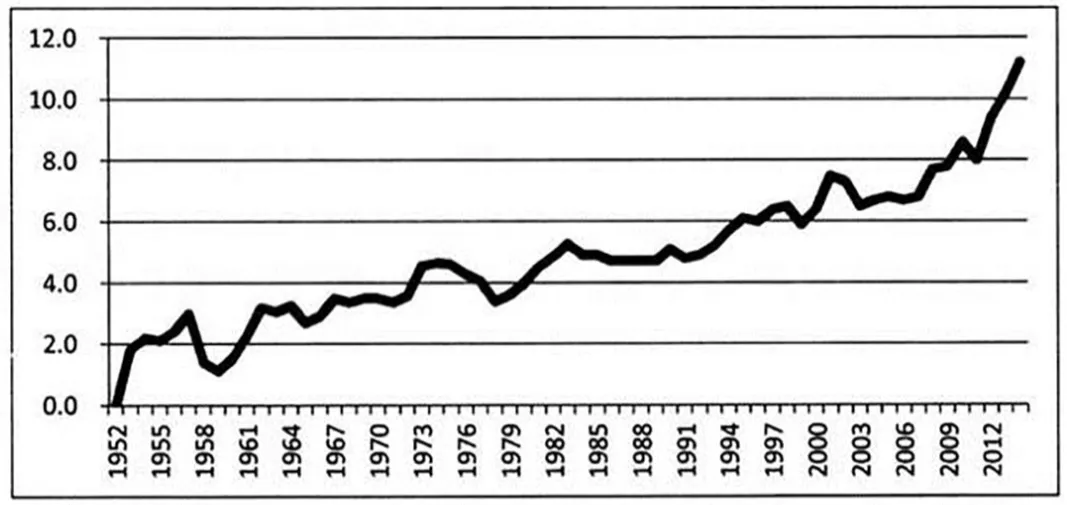
Figure 3 Proportion of China's Non-fossil energy Consumption from 1952 to 2014 (%)Data Source: Official Wabsite of National Bureau of Statistics of China. Retrieved from http://www.stats.gov.cn/ztjc/ztsj/201502/P020150212308266514561.pdf
Meanwhile, China has made unremitting efforts in optimizing the energy mix. In the total energy consumption of 2014, the consumption proportion of coal, petroleum, natural gas and non-fossil energy respectively accounted for 66.0%, 17.1%, 5.7% and 11.2%. In 2015, the non-fossil energy increased to 12%, which surpassed the target set by the 12th Five-Year Plan and represented a constant rise in the proportion of non-fossil energy consumption (See Figure 3).
The first white paper China’s Policies and Actions for Addressing Climate Change, released in 2008, stated “It is necessary for China to promote sustainable development and build a resourceconserving and environmentally friendly society and an innovation-oriented country amidst efforts to address climate change. Meanwhile, it should take economic development as the core,ecological protection and building as the focus and advancement of science and technology as the prop in a bid to control and mitigate greenhouse gas emissions and constantly enhance the capability to adapt to climate change.”①The State Council Information Office of the People’s Republic of China issued China’s Policies and Actions for Addressing Climate Change in 2008. Retrieved from http://www.gov.cn/zwgk/2008-10/29/content_1134378.htmThis document has thrown light on China’s fundamental path to cope with climate change. Under the guidance of this path, China has made persistent efforts to optimize economic structures, advance technological developments, improve energy utilization efficiency,develop low-carbon and renewable energy, carry out reforestation, control population growth, strengthen the formulation of laws, regulations and policies,establish relevant fully-fledged mechanisms and organizations, enhance support capacities for scientific research on climate change, and conduct climate change education and publicity. Therefore,it is well-founded to say that China has kept its feet on the ground and remained on course in coping with climate change. Its efforts have taken into full consideration the coordinated action and reform of economic, political, cultural, social and environmental respects and embodied China’s autonomy in fighting climate change.
3. Challenges facing China in coping with climate change
The reason why China has remained on course to combat climate change and made some excellent progress mainly lies in China’s political system which possesses a strong capacity to cope with risks and is able to “pool resources on large undertakings”.China’s governing party—the Communist Party of China has a solid base, a sound organizational system, a wealth of political experience and a strong capacity in building a consensus on climate change.Moreover, through effective social mobilization,it has incorporated climate change efforts into all manner of social and economic work, endeavoring to synchronize environmental protection and economic development and combine national shortterm and long-term interests, and proposed a holistic social transformation vision and strategy. At present,China is putting into practice a series of reforms with economic supply-side structuralreform at its core, including the establishment of a value system themed on striving for a green and ecological lifestyle that plays an important role in steering the public towards rational expectations and encouraging Chinese citizens to define a good life as one including environmental protections. With its vast territory and large population, China is naturally confronted with complex climate conditions, fragile ecological environments and more complicated international situations. Subsequently, its way to fight climate change is beset with tough challenges.
As for domestic challenges it is imperative for the Chinese government to spread its awareness and acknowledgment of climate change to all regions and diversified populations to gain wide and powerful social support and foster social forces to combat climate change. This is a big challenge,for the Chinese public has limited knowledge about climate change. There exists a marked development gap between urban and rural areas, different regions, industries and populations and such a gap has given rise to the difference in interests of the various stakeholders. For example, according to the data released by the National Bureau of Statistics,in 2015, the Gini coefficient of Chinese residents’income stood at 0.462. Though trending toward a gradual decline since 2008, this figure remained much higher than the “maximum” and well above the global average of 0.44. Based on the rural poverty alleviation standard of per capita income of RMB 2,300 (2010 value), there was a povertystricken population of 70.17 million in rural China in 2014. At the same time, there was a population of approximately 20 million in urban China who fell into the category of recipients of subsistence allowances.
It is necessary now for China to maintain a balance between fighting climate change and advancing development. There is no doubt that China is still a developing country with lower levels of economic development and more prominent contradictions between economic development,poverty eradication and environmental protection.Considering the average level and wide gap in domestic development and the gap between China and the developed countries, to further boost national development serves both the overall and long-term interests of China.
Also, it is essential for China to ensure that the enthusiasm for fighting climate change keeps pace with the available resources, especially technological resources. Both reducing and adapting to climate change are premised on an abundance of resources,in particular advanced technological means.Although China has attached great importance to research and capacity building for climate change control, and never ceased to improve relevant support systems, it still does not possess fullfledged advanced technology and has to depend on developed countries for many needed systems.Unfortunately, developed countries do not do well in technological transfers. Meanwhile, China is also in urgent need of raising the large amounts of capital to cope with climate change, which remains an ongoing difficulty.
Finally, it is crucial for China to ease the tension between policy goals and its policy implementation mechanisms in coping with climate change. Its administrative system is extremely decentralized and layered which leads to institution-related low efficiency in spite of a seemingly monolithic structure. China has been constantly advancing the reform of its political and administrative systems,with a view to the improvement of administrative efficiency as one of its major goals. For instance,China is launching the reform on the vertical administration system for law enforcement in monitoring and supervision by environmental protection institutions at or below the provincial level. It is aimed at breaking local protectionism and improving the quality and efficiency of environmental protection undertakings. Despite all that, it is still hard to say what on earth the reform will bring to China.
In terms of international challenges, the principle of common but differentiated responsibilities is not carried out effectively. Developed countries have failed to perform their due responsibilities for historical emissions. Even based on current emissions, China’s per capita emissions are still below that of the United States (see Figure 4).Concurrently, the wealth polarization tendency across the globe has not been alleviated. According to the Global Wealth Report 2014 of Credit Suisse,the global wealth was 20% higher than the peak before the financial crisis of 2008. The wealth of North America saw the greatest increase, accounting for 34.7% of the total global wealth; Europe ranked second, at 32.4% of the total global wealth. The number of wealth holders with at least USD 50 million of global assets reached around 128,000.Almost half were in the United States, while 25%in Europe. China thus needs to make efforts for responsibility sharing on a fair basis and contest the unequal world political and economic system.
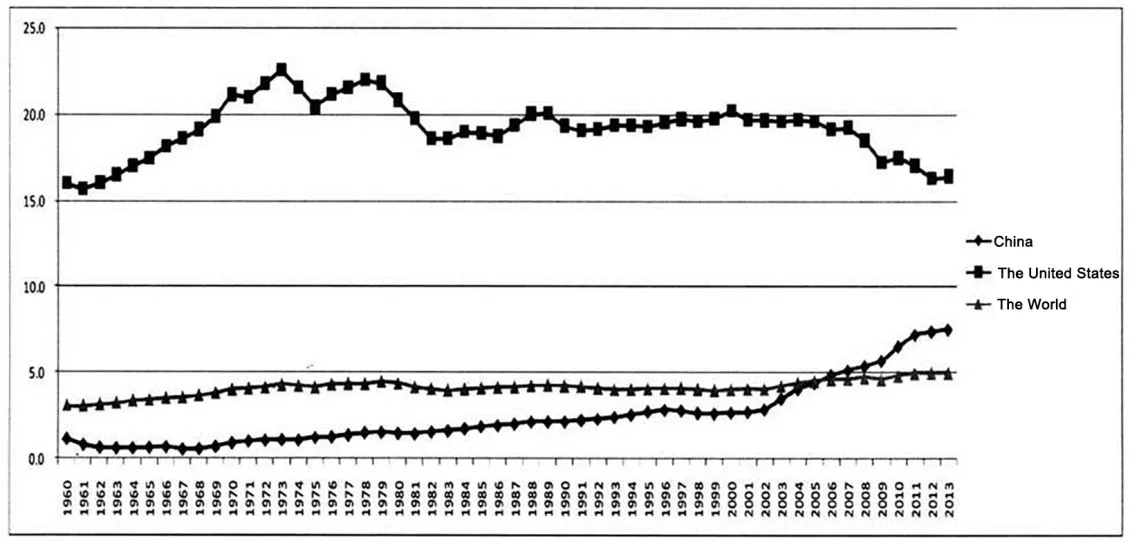
Figure 4 CO2 Emissions Per Capita of China, the United States and the world from 1960 to 2013 (Unit: million ton)Data Source: World Bank Statistical Yearbook. Retrieved from http://data.worldbank.org/indicator/EN. ATM.CO2E.KT
Moreover, the total amount of greenhouse gas emissions in China continues to increase with the constant expansion of its economy (see Figure 1 above) which means a larger share of global emissions. This creates not only more responsibilities for China, often requested by developed countries, but also higher expectations from some developing countries and those more vulnerable to climate change. As the fulfillment of responsibilities is closely related to the development of relations between countries, China must consider making more commitments and contributions to the international community.
Developed countries must undertake to transfer cutting-edge technologies to, and provide financial support for, developing countries in accordance with related provisions in various international conventions, thus providing the developing countries with more capabilities for combating climate change.Those commitments, however, are mere lip service and cannot effectively meet the needs of developing countries. China needs to serve as supervisor and facilitator in this regard, and meanwhile redouble its efforts in boosting independent innovation.Engaging in global governance and addressing global crisis is a process of continuous learning and innovation for China, a developing country that needs to accumulate experience for the long term.
Faced with complex challenges both at home and abroad, China has no choice but to be realistic in its treatment of climate change and embed it in its own development process. Any action to break away from China’s development practice will hardly end with effective and sustained results. Doubtlessly, the reduction of greenhouse gas emissions is important and to which China is dedicated. Whereas it is of equal significance to adapt to climate change, China needs to continue to strengthen its ability to adapt to climate change in the pursuit of innovation and development. As to carbon emission reductions,China always sticks to its own principle and process and actively advocates voluntary reduction no matter whether the rest of the countries act or not.It is also keenly aware that China has set green development as its fundamental trend during the transformation of development strategies. China is trying to search for new development opportunities in response to environmental crises (including climate change), create a new path and model for development, ultimately shaping a new type of social life and building a new social pattern. It is surely worth mentioning that China has expressed greater hope for closer and more effective international exchanges and cooperation, and for the settlement of global crises like climate change by supporting a community with a shared future for all mankind.
4. Sociological signi fi cance of practices to combat climate change
The foregoing analysis of China’s practice to combat climate change has revealed the social complexities of the climate change issue. The phenomenon of climate change might be clearly interpreted for its physical existence and its possible impact on mankind and Earth’s eco-systems from the perspective of natural sciences, but it is just a superficial exploration of climate change. It must be stressed that climate change is attributable to mankind and humans must act to cope with climate change. Attention should be paid to the social complexities behind climate change and the focus should be put on complicated social subjects, the dynamics and processes resulting in climate change and those involved in the settlement of climate change. In this sense, climate change can be seen as a social fact with social attributes that require in-depth research from the perspective of social sciences (especially sociology). Up to now, there is still a lack of research on climate change from the social sciences, which prevents mankind from gaining a deeper understanding of, and effective treatment for, climate change.
As I mentioned earlier, the sociological community is paying little attention to research on climate change, as is the international sociological community (Dunlap & Brulle, 2015). As for political innovations for responses to climate change, Giddens (2009) noted that “we do not have systematic politics for climate change.” As a matter of fact, we are facing more than just inadequate political innovation. To a large extent, innovations in economic, social and cultural systems also need further improvements as they are now underway in an unbalanced manner among the great variety of countries and regions. In the attempt to address climate change, we are basically dealing with this emerging global issue under the existing social system, a way of “putting new wine in old bottles.”The obvious result is some got while others lost.To combat climate change more effectively, it is imperative for us to carve a down-to-earth road without conservatism or radicalization to innovate social systems through more in-depth and pragmatic research in the social sciences.
Observing and analyzing social practices to address climate change allows us to further check the biophysical factors that affect the functioning of our social systems. These factors are known and exerted a widespread impact prior to the appearance of modern sociology. Nevertheless, modern sociology denies both biological determinism and geographical environmental determinism,and unilaterally emphasizes the importance of cultural and social factors for human behaviors in social functioning and social systems. This theoretical tendency has been considered to be anthropocentric (Catton & Dunlap, 1978). Under the influence of climate change, not only human concepts, attitudes and behaviors, but also social conflicts and social injustice are changing.Political and economic systems are also reforming,accompanied by more and more technological innovations and system designs. It is thus difficult for us to say the functioning of modern society is not related to biophysics. Hence, there is no reason to ignore biophysical factors in the analysis of social functioning.
China has independently promoted the overall reform of its social system in a bid to create an ecological civilization, a new form of social civilization, through practical institutional development. Progress and major challenges are mixed for China in coping with the growing environmental crisis and climate change. This social practice may function as a real case for us to sniff out some possibility for a new modernity. The old modernity increasingly strains the relations between man and nature, man and society, and between people, and manifests striking disruptions. If left unchecked, it will exacerbate the predicaments we are now experiencing. Absolute negation of the old modernity is unrealistic and probably false. We must center on the continuation of living practice to explore a new path of civilized development.What we can conclude from China’s practices may be: What role does a country play in coping with climate change? How can political consensus be reached? In what way can coping with climate change be embedded in economic development?What measures are taken to advocate and enhance new social values? Any significant progress in China’s practice will inject new hope into the future of our societies.
Of course, the practices of coping with climate change have also created new opportunities and room for a large number of empirical studies in the sociological field. Foremost, sociology can better describe the social facets of climate change. Though sociology doesn’t probe into the natural facets of climate change, we can utilize sociological methods to initiate who, what and why discussions about climate change in our societies. Sociology can also intuitively reveal the non-equilibrium of society in cognition and action on climate change. Based on various theories of power, interest and values, we can utilize the methods of social structures, processes and practice analyses to find the reasons behind this non-equilibrium.
In addition, we, resorting to sociology, can more specifically analyze complex processes of mankind and of human society to comprehensively uncover the complicated and varied impact of climate change on societies, economies and cultures, and in particular, the differential distribution of this impact and its consequences including social injustice and conflicts.
Sociology can contribute to climate governance through the provisions of extensive alternatives to climate governance. In this way, we can develop more detailed evaluation on climate governance,and constantly improve the system, structure, policy,mechanism and practice of climate governance.
The emergence of climate change and the complexity of coping with it remind sociologists once again of keeping a reflective, critical and constructive attitude toward their research subjects and meanwhile insisting on self-reflection and selfcriticism. The development of modernity often comes with unexpected consequences. Only keeping a sober mind in reflection and criticism can we constantly modify our recognition about social functioning and development, thus making clear some unspecified presuppositions for research and practices and enriching options for social action. As some researcher pointed out, the critical perspective of sociology is helpful for “exposing the takefor-granted nature of ideological blindfolds and opening up knowledge space for a great variety of alternative ideas that could lead to innovative and more effective strategies to combat climate change”(Dunlap & Brulle, 2015, p. 17). Sociologists, are both participants in the process of modern society and social learners, both social builders and social critics.
I would like to tell a story or legend passed down in the East and West respectively. There is a Chinese story about how Emperor Yu tamed the flood said to take place around 2000 BC. To tame the rampant floods, Gun blocked while Yu dredged. Both were courageous enough to face and solve the problem squarely, in particular Yu. He lead people to dredge and control the hazards of the flood, and improved the adaptive capacity of his society. As a result, he became an outstanding leader. In the West, a great flood was also recorded in the Bible. It happened in about 2000 BC. But Noah made a giant ark by God’s revelation and successfully survived the flood. It is very interesting to put these two stories together,which suggest different wisdom and ways to cope with disasters. The Chinese story highlights the courage to face obstacles and the wisdom to follow the tide and actively adapt oneself to the situation.In my opinion, avoidance and circumvention is a choice for us to confront with climate change and other disasters, but it is much wiser to face disasters squarely and adapt to them. It is of great necessity for mankind to challenge and reform.
(Translator: Zhang Qiuyue; Editor: Xiong Xianwei)
This paper has been translated and reprinted with the permission ofSociological Review of China, No. 2,2017.
REFERENCES
Catton, W. R. Jr. & Dunlap, R.E.(1978).Environmental sociology: A new paradigm.The American Sociologist,(13):41-49.
Dunlap, Riley E. & Robert J. Brulle. (2015).Climate change and society: sociological perspectives. Oxford University Press.
Huang Lele, Ren Lei & He Wei. (2016). On Chinese public awareness and attitudes towards climate change.Studies on Science Popularization(3).
Zhang Qian. (2011). Herders’ social culnerability to climate change: A case of desert grassland in Inner Mongolia.Sociological Studies(6).
 Contemporary Social Sciences2018年2期
Contemporary Social Sciences2018年2期
- Contemporary Social Sciences的其它文章
- Chinese Costumes and the Spirit of Chinese Aesthetics
- Order of Precedence Between Local Laws of Cities with Subordinate Districts and Regulations of Provincial Governments Clarifying Premises for Discussion Based on the Characteristics of Laws
- Building a Community with a Shared Future for Mankind:International Law-based Principles and Approaches
- The Content and Approaches of Human Resource Development in Impoverished Rural Regions in the Context of Targeted Poverty Alleviation
- Five Dialectics of Xi Jinping’s Theory on Ecological Progress
- Sharing Economy: A New Economic Revolution to Step into an Era of Ecological Civilization
